IN THE BEGINNING
The Epiphone story does not follow a straight line. For
more than a century, it has twisted and turned through triumph, setback and
comeback; hitting both dizzying highs and crushing lows as it winds its
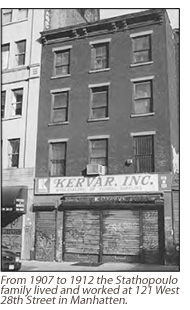 way through the ages. The
latest chapter, in 2007, finds Epiphone as one of the most successful and
respected instrument manufacturers on the planet. The opening chapter begins
some 130 years before that, in the workshop of Anastasios Stathopoulo. way through the ages. The
latest chapter, in 2007, finds Epiphone as one of the most successful and
respected instrument manufacturers on the planet. The opening chapter begins
some 130 years before that, in the workshop of Anastasios Stathopoulo.
The son of a Greek timber merchant, Anastasios would not
follow his father into the family trade, although his chosen profession would
use the same materials. He began crafting lutes, violins and traditional
Greek lioutos in 1873. A few years thereafter, Anastasios sailed across the
Aegean Sea with his family to start a new life in Turkey. By 1890, his talent
and reputation had allowed him to open an instrument factory and start a
family. First to arrive in 1893 was a son, Epaminondas, followed later that
decade by Alex, Minnie and Orpheus.
By 1903, the persecution of Greek immigrants by the native
Turks had forced the Stathopoulo family to move again; this time to a residence
in the lower Manhattan neighborhood of New York. With Anastasios crafting
and selling his instruments on the ground floor, and the family living directly
above, the line between work and home life became increasingly blurred.
Epaminondas (known as 'Epi') and Orpheus ('Orphie') were soon helping out
in the shop and learning the business from the ground up.
And business was good. It was Anastasios' good fortune
to arrive in New York at the height of the mandolin craze, and this dovetailed
with the popularity of
his traditional Greek instruments amongst the city's bustling community.
Thanks to the success of their father's instruments (now labelled 'A.
Stathopoulo, manufacturer-repairer of all kinds of musical instruments',
and built in a warehouse on 247 West 42nd Street), the Stathopoulo children
enjoyed a privileged upbringing and a good education. But all that changed
in July 1915, when Anastasios died at the age of 52 from carcinoma of the
breast.
EPI TAKES CHARGE
Epi was just 22 when he took charge of the family business.
He inherited many of his father's strengths - including a keen business sense
and fierce pride in his work - but combined this with an awareness of the
changing times that would prove vital in the years to come. Crucially, Epi
was not just a luthier or a businessman. He was also a keen musician and
socialite.
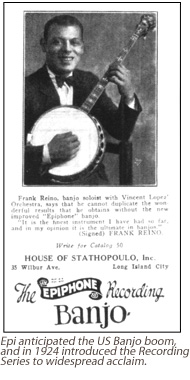 Epi
respected the tradition of his father's instruments, but recognized the
importance of moving with the times. By 1917, he had changed the company's
name to the 'House Of Stathopoulo' and began adapting the product line. Mandolins
were falling out of favor. In the post-war era, banjos had started to boom
along with jazz, and Epi, with his ear to the ground, recognized this early
and armed his company to deal with it. Not only did Epi introduce a line
of banjos, but he also developed the instrument's design, patenting his own
tone ring and rim construction. It was a sign of things to come. Epi
respected the tradition of his father's instruments, but recognized the
importance of moving with the times. By 1917, he had changed the company's
name to the 'House Of Stathopoulo' and began adapting the product line. Mandolins
were falling out of favor. In the post-war era, banjos had started to boom
along with jazz, and Epi, with his ear to the ground, recognized this early
and armed his company to deal with it. Not only did Epi introduce a line
of banjos, but he also developed the instrument's design, patenting his own
tone ring and rim construction. It was a sign of things to come.
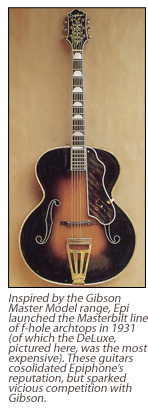 And
so, while the market shift caused some companies to flounder, the House Of
Stathopoulo flourished. The firm's structure was re-organized in 1923 as
its success snowballed (Epi made himself president and general manager) and
even its name was revised to reflect its changing identity. This was the
age of possibility, and Epi needed a brand to match. He eventually settled
on an amalgamation of his own nickname and a derivation of the Greek word
for 'sound'. It was the birth of Epiphone. And
so, while the market shift caused some companies to flounder, the House Of
Stathopoulo flourished. The firm's structure was re-organized in 1923 as
its success snowballed (Epi made himself president and general manager) and
even its name was revised to reflect its changing identity. This was the
age of possibility, and Epi needed a brand to match. He eventually settled
on an amalgamation of his own nickname and a derivation of the Greek word
for 'sound'. It was the birth of Epiphone.
In 1924, Epiphone released the Recording Series of banjos
to universal acclaim. Indeed, the Deluxe, Concert, Bandmaster and Artist
models (plus the budget Wonder model) were so popular that by the following
year, Epi had expanded production and bought out the Favoran banjo firm to
cope with demand. Thanks to models like the Emperor, and the endorsement
of players like Carl Kress, this side of the business continued to grow along
with Epiphone's reputation, to the point where the company's name was changed
once again in 1928. For now, it would be known as the Epiphone Banjo
Company.
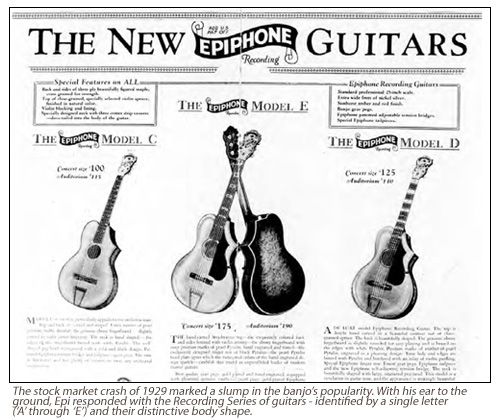
THE FIRST GUITARS
The stock market crash of 1929 drew a line under the age
of prosperity. Combined with the sudden slump in the banjo's popularity,
it sounded the death knell for many instrument manufacturers. Once again,
Epi was ready for the change. At the height of the banjo boom in 1928, he
had introduced the Recording series of guitars, each one identified only
by a letter ('A' through 'E') and notable for their unusual body shape. The
Recording guitars were a combination of spruce and laminated maple, with
either an arched or flat top, depending on the price.
The market was certainly ripe, but the Recording guitars
were not a success. One problem was a lack of celebrity endorsement. The
other was a lack of volume. The Recording guitars were too small and arguably
too ornate, particularly in comparison to the mighty size and volume of the
Gibson L-5. At least Epi was taking notes. It wasn't hard to see the L-5's
influence on the new Epiphone archtops that followed
in 1931, with the Masterbilt Series sharing similar f-holes, pegheads, and
even a similar name to the Gibson Master Model range (though the individual
model names would be more interesting than Gibson's serial number system,
including the DeLuxe, Broadway, Windsor and Tudor). Despite taking inspiration
from Gibson, however, the Masterbilts had their own identities. Their intention
was not to emulate the Master Model range, but to destroy it.
EPIPHONE VERSUS GIBSON
Throughout the 1930s, the rivalry between Epiphone and
Gibson would veer from friendly sparring to all-out warfare. Slighted by
the introduction of the Masterbilts, and having emerged from its commercial
slump at the
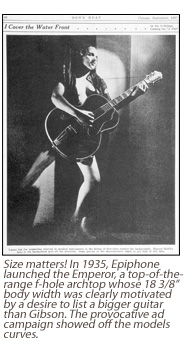 start
of the decade, Gibson returned fire in 1934 by increasing the body width
of its existing models and introducing the king-size Super 400 (named after
its $400 price tag). Not to be outdone, Epi replied the following year with
the top-of-the-line Emperor, which raised the stakes with a slightly wider
body and a provocative advertising campaign featuring a semi-naked woman.
In 1936, Epiphone struck again, increasing the size of its De Luxe, Broadway
and Triumph models by an inch (making them 3/8" wider than the Gibsons). start
of the decade, Gibson returned fire in 1934 by increasing the body width
of its existing models and introducing the king-size Super 400 (named after
its $400 price tag). Not to be outdone, Epi replied the following year with
the top-of-the-line Emperor, which raised the stakes with a slightly wider
body and a provocative advertising campaign featuring a semi-naked woman.
In 1936, Epiphone struck again, increasing the size of its De Luxe, Broadway
and Triumph models by an inch (making them 3/8" wider than the Gibsons).
By this point, Epiphone guitars were considered to be
amongst the best in the world, and Epi himself was enjoying the patronage
of some of the most respected players on the scene. The Epiphone showroom
- now returned to its early location on West Street, Manhattan - was both
the company's HQ and a hangout for famous musicians. On Saturday afternoons,
Epi would simply open the display cases and allow legends-in-waiting like
Al Caiola and Harry Volpe to jam for the benefit of the people watching on
the pavement outside. Perhaps this wasn't just an act of benevolence: both
players would later go on to endorse Epiphone instruments, along with many
others including Les Paul.
Epiphone wasn't just gunning for Gibson. Growing aware
of the success of Rickenbacker's electric models since 1932, Epi made his
move on this new market with the introduction of the Electar Series (originally
known as Electraphone) in 1935. The design was strong, with individually
adjustable polepieces on the 'Master Pickup' giving optimum output, and while
Gibson had evidently been thinking the same thing (by the following year
they had introduced an electric Hawaiian guitar), the Electar line landed
a serious blow on Epiphone's rivals, while consolidating their own reputation
as innovators. By the summer of 1937, Epi reported that sales had
doubled.
As the decade played itself out, the rivalry between Epiphone
and Gibson showed little sign of abating. In 1939, the two firms introduced
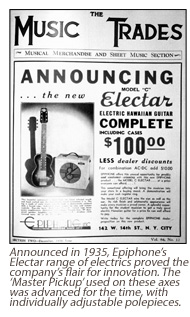 similar 'pitch-changing'
Hawaiian guitar designs. That same year, Gibson introduced a line of violins,
while Epiphone struck back with a series of upright basses. It took the outbreak
of the World War II, and the shutdown of US guitar production, to ring the
bell on the bloodiest luthier boxing match of the age. similar 'pitch-changing'
Hawaiian guitar designs. That same year, Gibson introduced a line of violins,
while Epiphone struck back with a series of upright basses. It took the outbreak
of the World War II, and the shutdown of US guitar production, to ring the
bell on the bloodiest luthier boxing match of the age.
HARD TIMES
The war changed everything. Before the bombing of Pearl
Harbour in 1941, Epiphone had been riding on the crest of a wave. When the
last of the fighting ended in 1945, the company found itself without its
greatest asset. Tragically, Epi had died of leukemia during the war, meaning
that Epiphone was handed down to younger brothers Orphie and Frixo, who would
respectively be responsible for the financial and mechanical running of the
operation.
The problems weren't obvious to start with. Epiphone continued
to clash with Gibson via the introduction of cutaway versions of the Emperor
and De Luxe, and raised the bar considerably with the arrival of the electric
cutaway De Luxe. Pickups continued to be refined, and famous players continued
to appear onstage armed with Epiphone guitars. From the outside, it seemed
to be business as usual.
But cracks soon appeared, both on the production line
and in the boardroom. The Stathopoulo brothers were not getting along, and
in 1948, Frixo offloaded his share to Orphie. Worse, the company was losing
the reputation for craftsmanship and innovation built up during Epi's reign,
and the pressures for unionization compounded the problems. To sidestep this
last issue, the Epiphone factory moved from Manhattan to Philadelphia in
1953, but the fact that many of the firm's craftsmen refused to leave New
York resulted in a drop in quality and the very real danger of
bankruptcy.
THE UNION OF EPIPHONE AND GIBSON
While Epiphone's problems got worse as the 1950s progressed,
Gibson was going from strength to strength. Its main competition now came
from 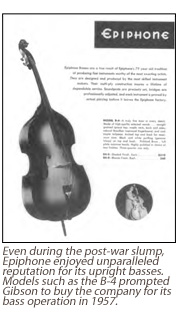 the California-based
Fender Company, creator of the Telecaster and Stratocaster models that had
been released earlier that same decade. If Gibson had a weakness, it was
that their upright bass production had stopped before the war and never started
again. So when Gibson's general manager, Ted McCarty, received a call from
Orphie asking whether he'd be interested in buying out the Epiphone bass
business (still a hugely respected division of the company, despite its
troubles), he didn't need asking twice. McCarty paid the $20,000 asking price
and Gibson took control of Epiphone in May 1957. the California-based
Fender Company, creator of the Telecaster and Stratocaster models that had
been released earlier that same decade. If Gibson had a weakness, it was
that their upright bass production had stopped before the war and never started
again. So when Gibson's general manager, Ted McCarty, received a call from
Orphie asking whether he'd be interested in buying out the Epiphone bass
business (still a hugely respected division of the company, despite its
troubles), he didn't need asking twice. McCarty paid the $20,000 asking price
and Gibson took control of Epiphone in May 1957.
Gibson's original intention was to harness the reputation
of the Epiphone bass line. By 1957, this plan had been scrapped. Instead,
McCarty wrote in a memo that year, the Epiphone brand would be revived and
a new line of instruments created. These Gibson-made Epiphones would then
be offered to dealers who were keen to win a Gibson contract, but still earning
their stripes (the right to sell Gibson models was hotly contested between
dealerships at this time). It was the perfect solution. Dealers would get
a Gibson-quality product, without treading on the toes of the traders who
already sold the real thing. The Epiphone operation was relocated to Kalamazoo
(the same city as Gibson HQ) and work began.
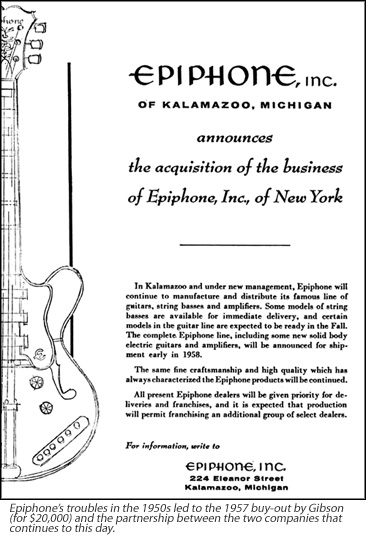
A NEW BEGINNING
Epiphone wouldn't stay in the shadow of Gibson for long.
When the new line started filtering through in 1958, it became clear that
the brand now had three separate identities. On one hand, Epiphone now listed
budget-conscious versions of existing Gibson models. Alongside this, however,
there were also recreations of classic Epiphone designs (such as the Emperor,
Deluxe and Triumph) and a selection of new models that had never been seen
before. These included electrics like the semi-hollow Sheraton and the
solid-bodied Moderne Black (alongside a double-cutaway model inspired by
the Telecaster), and flat-top acoustics like the Frontier, whose
square-shouldered body style was a first for Gibson (it was traditionally
a Martin design). Combined with the introduction of amplifiers, it was becoming
clear that Epiphone instruments would be far more than the 'sort of almost
Gibsons' many had predicted.
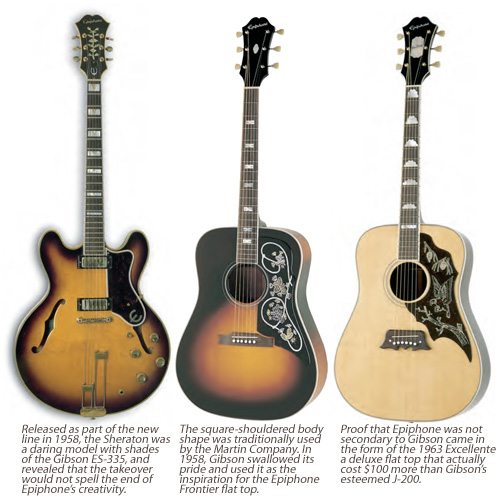
The grand unveiling of the Epiphone line took place at
the NAMM trade show in July 1958, with an electric Emperor as the flagship
model. The show itself would generate orders of 226 guitars and 63 amps (a
modest return), but over the next few years Epiphone would get into a swagger,
shifting 3,798 units in 1961, and accounting for 20% of the total units shipped
out of Kalamazoo by 1965. Even more impressive was the prestige of the guitars
themselves. In the early 1960s, the Epiphone Emperor cost significantly more
than the top-of-the-range Gibson Byrdland, while 1963's deluxe flat top
Excellente was $100 more than the J-200, and made of rarer tonewoods.
The early 1960s brought the explosion of folk music, and
Epiphone was ready to cater to it. The firm reintroduced its Seville classical
guitar (with and without pickups) in 1961, and complemented this with the
Madrid, Espana and Entrada models. In 1962, Epiphone also started listing
a twelve-string guitar called the Bard, a smaller version known as the Serenader,
and (in 1963) a series of steel-string flat-topped folk guitars
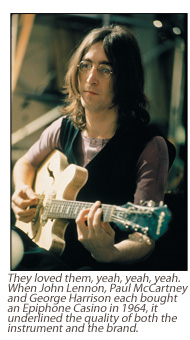 including the Troubadour.
The strength of the acoustic range was matched by a number of electric classics,
like the double-cutaway Casino, and by the time the Beatles appeared with
three of these models (one each for John Lennon, Paul McCartney and George
Harrison), it seemed like the rubber stamp on Epiphone's recovery. The company
now listed fourteen electric archtops, six solid-bodied electrics, three
basses, seven steel-string flat tops, six classicals, four acoustic archtops,
three banjos and a mandolin. including the Troubadour.
The strength of the acoustic range was matched by a number of electric classics,
like the double-cutaway Casino, and by the time the Beatles appeared with
three of these models (one each for John Lennon, Paul McCartney and George
Harrison), it seemed like the rubber stamp on Epiphone's recovery. The company
now listed fourteen electric archtops, six solid-bodied electrics, three
basses, seven steel-string flat tops, six classicals, four acoustic archtops,
three banjos and a mandolin.
TURNING JAPANESE
The early to mid-1960s were boom time for Epiphone, with
unit sales increasing fivefold between 1961 and 1965. But the good times
couldn't 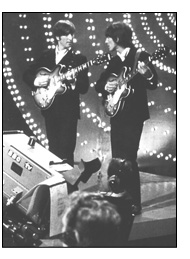 last forever.
The rise of foreign-made guitars had caught the US industry napping, and
by 1969, these cheap models (often based on existing American designs) had
stolen some 40% of the Epiphone/Gibson market share and closed many companies
down entirely. last forever.
The rise of foreign-made guitars had caught the US industry napping, and
by 1969, these cheap models (often based on existing American designs) had
stolen some 40% of the Epiphone/Gibson market share and closed many companies
down entirely.
There were other problems. Gibson manager Ted McCarty
had stepped down, the quality of the product was thought to have slipped,
and union problems were simmering again. In its weakened state, Gibson's
parent company CMI was bought in 1969 by the Ecuadorian ECL corporation (whose
experience was not in guitars, but beer) and Epiphone found itself in a
predicament - perceived to be secondary to Gibson, but too expensive to compete
with the foreign imports.
The idea of moving Epiphone production to Japan had actually
been floated before the ECL takeover. By 1970, it was a reality, with American
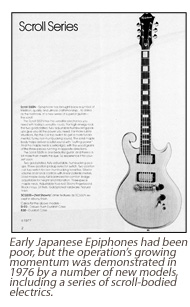 production grinding to
an abrupt halt and a new line of Epiphones being exported from the Japanese
town of Matsumoto. But these were not Epiphones as the world knew them. On
the contrary, they were just rebadged versions of models that were already
being produced by the Matsumoku Company - with little imagination or respect
for the company's pedigree. production grinding to
an abrupt halt and a new line of Epiphones being exported from the Japanese
town of Matsumoto. But these were not Epiphones as the world knew them. On
the contrary, they were just rebadged versions of models that were already
being produced by the Matsumoku Company - with little imagination or respect
for the company's pedigree.
Things had improved by 1976, when the Epiphone line was
bolstered by the appearance of models like the Monticello, a series of
scroll-body electrics, and the new Presentation range of flat tops. There
was also the Nova series of flat tops and three new solidbodies named Genesis.
By 1979, the Epiphone product list was gathering speed, with over 20 steel-string
flat tops, and plenty more besides.
THE MOVE TO KOREA
Just as Epiphone's Far Eastern operation seemed to be
finding its feet, three bombshells dropped in quick succession. The first
was the rise of the electronic keyboard. The second was the rising cost of
Japanese production, which led to Epiphone's relocation to Korea in 1983,
and collaboration with the Samick Company. The third took place in the Gibson
boardroom at the start of 1986, with three Harvard MBAs (Henry Juszkiewicz,
David Berryman and Gary Zebrowski) taking the company off the hands of
ECL/Norlin. Reviving Gibson was the priority for the new owners, and with
Epiphone making less than $1 million revenue in 1985, there seemed a danger
it would be swept under the carpet and forgotten.
But Epiphone was still buzzing with potential. Soon enough,
Juszkiewicz had identified it as a sleeping giant, and made the trip to Korea
to decide how it could be pushed to match the success of other Asian brands
like Charvel and Kramer. As he absorbed Epiphone's pedigree, Juszkiewicz
started getting results, and soon sales were growing again.
Sales weren't the only thing on the move. By 1988, the
Epiphone product line was evolving. Epiphone now listed a new PR Series of
square-shouldered acoustics, along with an interpretation of Gibson's J-180,
several classical guitars, a banjo and a mandolin. There was also a solid
selection of Gibson-derived instruments (from flagship models like the Les
Paul and SG to new archtops like the Howard Roberts Fusion) and a tip of
the hat to Epiphone's past in the form of the Sheraton II.
TAKING ON THE WORLD
It was a start. But as the 1990s rolled around, Epiphone
still had work to do. The line was more than comprehensive - offering 43
different models 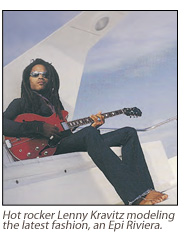 across
a range of styles and budgets - but the lack of historic Epiphone products
needed to be addressed. The legendary instruments from Epiphone's past should
have been leading the company's charge into the future. Without them, Epiphone
was still seen by some as a faceless import; a fact reflected by its modest
global sales. across
a range of styles and budgets - but the lack of historic Epiphone products
needed to be addressed. The legendary instruments from Epiphone's past should
have been leading the company's charge into the future. Without them, Epiphone
was still seen by some as a faceless import; a fact reflected by its modest
global sales.
Taking charge of Epiphone around this time, David Berryman
identified the other problem that was stopping the firm from taking on the
world. It still didn't have its own dedicated office or workforce. Moving
fast, Berryman instigated the acquisition of an office in Seoul, appointed
Jim Rosenberg as product manager and set about addressing the misconception
that Epiphone was secondary to Gibson.
The Seoul office was a major turning point. Instead of
the long-distance relationship that the firm had previously had with its
product, Epiphone was now able to roll up its sleeves and muck in with the
dedicated quality control staff at the factory. During the long days and
sleepless nights that followed, the Epiphone product changed beyond all
recognition. Factory
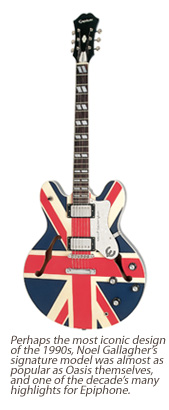 processes were assessed
and refined. Manufacturers were visited and briefed on the components that
would make these instruments special, with Epiphone taking a hands-on role
in the development of everything - from pickups, bridges, toggle switches
and fret inlays to unique features like the metal E logo and frequensator
tailpiece. Financially and emotionally, Epiphone invested everything it had
in these new models. processes were assessed
and refined. Manufacturers were visited and briefed on the components that
would make these instruments special, with Epiphone taking a hands-on role
in the development of everything - from pickups, bridges, toggle switches
and fret inlays to unique features like the metal E logo and frequensator
tailpiece. Financially and emotionally, Epiphone invested everything it had
in these new models.
It paid off. One of the first fruits of Epiphone's labours
was a limited-edition run of electric-acoustics, and the success of these
confirmed how far the company had come. By the time of the 1993 NAMM show,
there were more thin-bodied electric-acoustics and a new range of PRs. It
all hammered home the impression that Epiphone was a leader rather than a
follower.
But Epiphone was looking to the past as well as the future.
In 1993, a limited run of Riviera and Sheratons were produced in Gibson's
Nashville factory, with the company's Montana plant also building 250 Excellente,
Texan and Frontier flat tops. These Epiphones were only intended as a special
event (it was impractical to move production to the US permanently) but the
public reaction prompted Rosenberg to reissue many classic designs via the
Korean range. Those who attended the 1994 NAMM witnessed the re-introduction
of legends including the Casino, Riviera, Sorrento and Rivoli bass. In the
months that followed, word spread, and guitar luminaries including Chet Atkins
and Noel Gallagher signed up to the Epiphone cause - confirmation that these
were instruments to be played through choice, not necessity.
ONWARDS AND UPWARDS
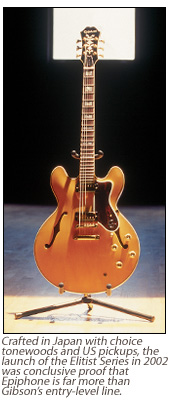 Epiphone
was arguably just as successful in the late-90s as at any point in its history.
With confidence booming, this era saw the launch of the Advanced Jumbo Series
and the release of several important signature models. The John Lee Hooker
Sheratons from the USA Collection were tasteful, toneful and utterly authentic.
The Noel Gallagher Supernovas had attitude and edge, and became some of the
most iconic designs of the time. Then there were the John Lennon 1965 and
Revolution Casinos. With their US birthright, unbeatable authenticity and
sense of aspiration, these models reunited Epi with the greatest artist of
all time, and underlined the company's own re-emergence as a rock
legend. Epiphone
was arguably just as successful in the late-90s as at any point in its history.
With confidence booming, this era saw the launch of the Advanced Jumbo Series
and the release of several important signature models. The John Lee Hooker
Sheratons from the USA Collection were tasteful, toneful and utterly authentic.
The Noel Gallagher Supernovas had attitude and edge, and became some of the
most iconic designs of the time. Then there were the John Lennon 1965 and
Revolution Casinos. With their US birthright, unbeatable authenticity and
sense of aspiration, these models reunited Epi with the greatest artist of
all time, and underlined the company's own re-emergence as a rock
legend.
As the new millennium came and went, the momentum continued,
as Epiphone introduced the Elitist range and strengthened its position in
the acoustic market with the acquisition of veteran Gibson luthier Mike Voltz.
 Voltz's
contribution to Epiphone's development cannot be overstated. While the firm
had revived its electric range to great acclaim, there was still a sense
that it needed to claw back its former reputation for world-beating flat
tops. All that changed with the introduction of the Masterbilt range, which
- along with the subsequent 2005 release of the Paul McCartney 1964 USA Texan
- consolidated Epi's acoustic credentials and reacquainted the firm with
two big names from its past. Voltz's
contribution to Epiphone's development cannot be overstated. While the firm
had revived its electric range to great acclaim, there was still a sense
that it needed to claw back its former reputation for world-beating flat
tops. All that changed with the introduction of the Masterbilt range, which
- along with the subsequent 2005 release of the Paul McCartney 1964 USA Texan
- consolidated Epi's acoustic credentials and reacquainted the firm with
two big names from its past.
By 2003, the international demand for Epiphones was such
that the company had opened a new factory in China. Not only did this mark
the first time that Epiphone had its own dedicated factory since the initial
takeover by Gibson but staffed by US managers and luthiers, it also armed
them with the control over their own product that would let them take development
to the next level, and give them a massive edge over the competition (most
of whom continued to share workspaces).
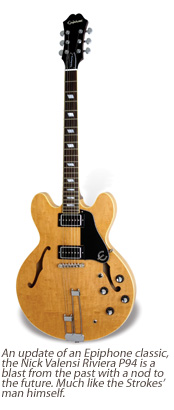 In
2007, Epiphone is all things to all players. Working musicians prize the
company for its Gibson replicas, offering the quality of the most famous
US models at competitive prices. Collectors of vintage guitars snap up the
authentic Elitist reissues of the Emperor, Casino and Excellente (and many
more). Recording artists turn to the Epiphone US range for quality that rivals
any guitar manufacturer in the world, while rock 'n' roll fanatics delight
in the company's signature models, which include everything from the Nick
Valensi Riviera to the Zakk Wylde Les Paul Customs. Regardless of budget,
ability or musical leaning, today's Epiphone line has it covered. In
2007, Epiphone is all things to all players. Working musicians prize the
company for its Gibson replicas, offering the quality of the most famous
US models at competitive prices. Collectors of vintage guitars snap up the
authentic Elitist reissues of the Emperor, Casino and Excellente (and many
more). Recording artists turn to the Epiphone US range for quality that rivals
any guitar manufacturer in the world, while rock 'n' roll fanatics delight
in the company's signature models, which include everything from the Nick
Valensi Riviera to the Zakk Wylde Les Paul Customs. Regardless of budget,
ability or musical leaning, today's Epiphone line has it covered.
Perhaps even more important, Epiphone has retained the
pioneering spirit that was always Epi Stathopoulo's calling card. Whether
through the 2006 'Guitar of the Month' scheme (offering a different collector's
model each month) or through its unending quest to challenge tradition, this
is still a firm that thrives on the risk while always delivering the result.
Perhaps David Berryman puts it best. "Gibson is a traditional company, Epiphone
is more of a renegade. It marches to the beat of a different drum. Always
has." One suspects that it always will.
EPIPHONE TIMELINE
1863 - Anastasios Stathopoulos is born in Sparta,
Greece to a local lumber merchant.
1873 - Anastasios builds his first instruments
(according to Epiphone literature of the 1930s).
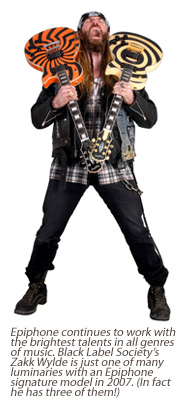 1877
- The Stathopoulos family moves to Smyrna in Asiatic Turkey. 1877
- The Stathopoulos family moves to Smyrna in Asiatic Turkey.
1890 - Anastasios establishes a large instrument
factory in Smyrna which provides violins, mandolins, lutes and traditional
Greek lioutos.
1893 - Epaminondas (Epi) is born to Anastasios
and his wife Marianthe. His name is inspired by a military hero from ancient
Greek history.
1903 - Following persecution of Greek immigrants
by the native Turks, the Stathopoulos family moves to New York (during the
immigration process the final 's' is dropped from the family name). The family
now includes sons Alex and Orpheus (Orphie), and daughter Alkminie (Minnie).
Another son (Frixo) and daughter (Elly) are born in America.
1915 - Ansatasios dies, leaving Epi in charge,
and ushering in the new era of the Epiphone company (although this brand
name is still some years away). Orphie is second-in-command, while Frixo
and Minnie will later become active in the company.
1917 - Epi begins labeling instruments with the
House of Stathopoulo brand. The era of the tenor banjo is beginning, and
Epi is granted his first patent for banjo construction.
1924 - Combining his own name with the Greek word
for sound, Epi registers the Epiphone brand name.
1925 - Epi buys the Favoran banjo company in Long
Island City (across the East River from Manhattan) and launches the Epiphone
Recording line of banjos. Their ornate design and classic tone makes then
an instant success.
1928 - Buoyed by the success of the Recording banjos,
Epiphone introduces a Recording line of guitars, most of them carved tops
and spruce/maple tonewoods.
1931 - Epiphone introduces a full line of f-hole
archtop guitars (12 models in all), with the top models (the DeLuxe, Broadway
and Triumph) becoming familiar Epi model names for the next 40 years.
1935 - As the latest blow in the long-running
competition with Gibson, Epiphone launches the Emperor.
1937 - Epiphone unveils its innovative adjustable-pole
pickup (as part of the Electar series). By this point, the company's reputation
has led to endorsements from prominent players such as Tony Mottola, Dick
McDonough and George Van Eps.
1943 - Epi dies of Leukemia, leaving brothers Orphie
and Frixo in charge. Feuding between them leads Frixo to sell his stock in
1948. The company falls on hard times in the post-war years, and by the mid-50s,
Epiphone is making few instruments aside from upright basses and the Harry
Volpe student guitar.
1957 - Gibson's parent company, CMI, buys Epiphone
for $20,000, originally intending to harness its upright bass operation,
but ultimately reviving the Epiphone name on guitars. A full line of newly
designed acoustics and electrics is unveiled in 1958, and two years later
Epiphone production moves into Gibson's factory in Kalamazoo, Michigan.
1961 - Country superstar Ernest Tubb equips his
entire Texas Troubadours band with Epiphones, while Marshall Grant plays
upright Epi bass with Johnny Cash.
1963 - Longtime Epiphone endorsee Al Caiola gets
his own model, and plays it on his hit records of the themes from Bonanza
and The Magnificent Seven.
1964 - George Harrison, John Lennon and Paul McCartney
buy Casinos. Alongside All You Need Is Love (which features the three), McCartney
uses his Casino for the solos on Ticket To Ride, while Harrison uses his
for the famous runs on Hello Goodbye. McCartney also buys an Epiphone Texan,
which he plays on Yesterday.
1970 - In the face of foreign competition, Epiphone
production is moved to Japan. Through the 1970s and early '80s, the Epiphone
line has little continuity, although it maintains respect as a quality import
brand.
1983 - Epiphone production is moved to Korea.
1986 - Henry Juszkiewicz, David Berryman and Gary
Zebrowski acquire Epiphone and Gibson. The Epi line is soon expanded to include
traditional models like the Sheraton, Emperor and Howard Roberts, along with
Epi versions of Gibson classics like the Les Paul, Flying V and
Explorer.
1992 - Jim Rosenberg arrives as product manager
to head up the Epiphone line, and soon expands it to offer virtually every
style of guitar to the value-conscious player. The opening of a dedicated
office in Seoul allows Epiphone the hands-on relationship with its product
that had previously been lacking.
1993 - Epiphone's reputation is further enhanced
by the Nashville USA Collection, limited edition models that represent the
first US-made Epiphones for over 20 years.
1994 - Gibson's Montana division follows suit,
offering a limited edition US run of the Excellente, Frontier and Texan Epiphone
flat tops. The NAMM show of that year also witnessed the re-introduction
of classic designs including the Casino, Riviera and Sorrento (all part of
the new Korean range).
1996 - With Oasis at the peak of their popularity,
Epiphone build lead guitarist Noel Gallagher the iconic Supernova signature
model.
1998 - Epiphone introduce guitar and accessory
"starter-packages" while this period also sees the launch of the Advanced
Jumbo Series.
1999 - John Lennon Revolution and '65 Casinos are
launched as part of Epiphone's USA Collection, alongside a pair of John Lee
Hooker Sheratons. The sheer quality and flair of these signature models
underlines Epiphone's growing status as a brand to be played through
choice.
2002 - The new Elitist line is released to widespread
acclaim, while veteran Gibson luthier Mike Voltz is recruited by Epiphone
to focus on acoustic production and marketing. Voltz will prove instrumental
in establishing the new range of Masterbilt acoustics, a series that reunites
Epiphone with its past and consolidates the company's position as a leader
in both the electric and acoustic fields.
2003 - International demand leads to the opening
of a dedicated Epiphone factory in China. Staffed by US managers and luthiers,
it equips the company to support the growing popularity of its
instruments.
2005 - Epiphone is reacquainted with a big name
from its past, as the Paul McCartney 1964 USA Texan is re-introduced.
2007 - The modern Epiphone catalogue offers greater
diversity than ever, with new Elitist and signature models rubbing shoulders
with faithful reissues and authentic versions of the Gibson line. |


